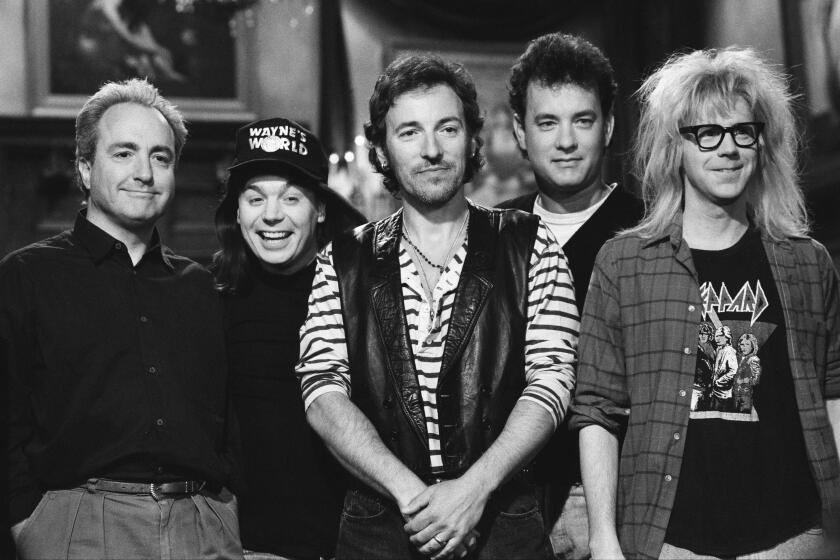Despite Demand, Cable Alternatives Slow to Materialize
- Share via
Cable television seemed a natural business extension for telephone companies in the wake of the Bell system breakup. The phone companies already had wire running into people’s homes and near-universal market penetration in their service areas.
Besides, there has long been widespread consumer dissatisfaction with the entrenched cable monopolies. “I’d rather buy cable service from my phone company than phone service from my cable company,” joke consumers fed up with what they see as high prices and inept service from traditional cable operators.
So why do most people still have only the choice of a local cable monopoly or a satellite dish?
High costs, technical hurdles and government regulation have proved to be more formidable than anticipated.
As recently as 1995, ventures such as Tele-TV (backed by three of the Baby Bells, including Pacific Telesis) were promising an imminent revolution in video delivery. Today, Tele-TV and a number of other forays have been cut back or scuttled.
US West announced recently it was splitting up its telephone and cable operations, having decided there was insufficient synergy between the two in today’s marketplace.
In the meantime, GTE Corp. and PacBell are proceeding with TV delivery services in Southern California. GTE is laying cable and has introduced service in Ventura County and is eyeing the Los Angeles area; PacBell is operating a remnant of the Tele-TV venture, a wireless (sent via microwave) service transmitted from a tower on Mt. Wilson to areas around Los Angeles and Orange counties. The services so far have a combined total of around 35,000 customers and still face numerous challenges.
For PacBell Digital TV, the challenges have included line-of-sight transmission problems and a parent company--SBC Communications--that has apparently decided to refocus on telephone rather than video services.
Sources say SBC is now entertaining bids for the Pacific Bell Digital TV service. At least one traditional cable company is said to be in the bidding, along with a group of several former PacBell executives.
Where does this leave the consumer? Confused, but welcoming change.
Bernie Wallen is one of at least half a dozen people on his tree-lined Oxnard street who are ready to switch. He’s fed up with his cable company; he says he can’t even get through to them on the phone.
“I got a flier from Jones [Intercable],” he says, walking to the living room to fetch the glossy, full-color mailer. “It says, ‘New Lower Prices.’ But in the small print below the ‘lower’ price for my package, they list the price with tax included. That’s what I’m paying now,” he says indignantly.
When a salesman for GTE Americast showed up at his door on a recent Friday afternoon, Wallen, 48, was primed. He signed on the dotted line for salesman Craig Key, 42, a rosy-cheeked evangelist for the cable co-venture between GTE Corp. and Walt Disney Co. (Disney negotiates programming, while GTE delivers the service to consumers.) Launched in Thousand Oaks in January 1996, the service is just now rolling out in Oxnard after several months of cable-laying.
Up and down the street, the story was much the same. One woman was so tired of dealing with the cable company that she canceled her service and installed a 20-foot antenna on her roof.
Gloria Gonzalez, 31, and a mother of three, was won over by GTE’s programming lineup.
“We give you the Disney Channel free. The other company charges you 10 dollars for that,” Key told Gonzalez, who stood holding her 1-year-old son, David Isaac, on her hip.
“What about Nickelodeon?” she asked. Assured that Nickelodeon is part of the basic service, Gonzalez signed up. GTE is booking service appointments seven days a week; Gonzalez chose the following Monday afternoon.
“I’d say 90% of the people I actually get to the door will sign up. It’s just a matter of talking to them and explaining the service,” said Key, one of 33 freelance salesmen knocking on up to three dozen doors a day for GTE Americast.
GTE spokesman Larry Cox said the company has so far signed up 23,000 customers in its Southern California service areas. Although he declined to give a specific dollar amount, he said GTE has spent more than $200 million on video services in Southern California and Florida, where it began offering cable in 1995.
GTE’s basic package, which has 64 channels including Disney, runs $26.95. Jones Intercable’s 52-channel package is $24.57. Instead of rock-bottom pricing, GTE stresses service (seven-day-a-week appointments) and value.
Steve Naber, general manager of Jones Intercable’s Oxnard operations, admitted Jones is watching GTE closely, and responding. But he said he’s not worried that his customers will switch en masse.
“I think competition is good in almost every market, and it’s excellent for the consumer,” Naber said. “What’s going to differentiate us is . . . the localness of Jones. When the power goes out or there’s an earthquake here, we know it. Plus, we have local programming.”
In contrast to GTE’s cheery sales campaign, PacBell’s roll-out has been furtive. A PacBell representative would will not give a specific number of customers, saying simply it is “over 11,000.” Although relatively few in number, those customers are desirable: PacBell’s average monthly revenue per subscriber is reportedly $50, a good $15 higher than the average cable customer.
One satisfied customer remembered that before he was able to give PacBell his money, he had to find its phone number (888-WATCHPB) and pass its inspection.
“Their number isn’t listed; I had to call friends to try to get it,” recalled Matthew Jacobson, an executive vice president of News Corp.’s News America Digital Publishing who lives in Manhattan Beach. “You call them, and they send out their ‘men in black.’ These four guys looked around my house and my roof for about four hours before they installed my system.”
Now that the 14-inch receiving dish is perched on his roof, Jacobson says he couldn’t be happier with the service. “It’s great reception and a good channel line-up--I get 50 to 60 basic channels, 50 pay-per-view channels and all local channels. And I love the on-screen programming guide; I work on that kind of stuff for a living,” he added.
PacBell representatives also would provide little information about who is being solicited for the service, and how. “Primarily, our marketing efforts have been direct mail. We do some door-to-door selling and door hangers,” said PacBell spokeswoman Julie Dodd Thomas, declining to name any specific communities being targeted by PacBell.
“Beyond the line-of-sight qualification, our marketing is based on the profile of potential customers. . . . we have a lot of different lists and methods,” Thomas said.
One reason she may be reluctant to elaborate is that the California Cable Television Assn. reportedly complained to the California Public Utilities Commission that PacBell was improperly using its telephone company assets to aid its video service operation. No action has been taken on the complaint, but it highlights the tension between traditional cable and the new interlopers.
The business intrigue behind the telephone companies’ cable ventures is of far less interest to the average cable customer than is a good, reliable and reasonably priced service.
Not everyone is thrilled with the way GTE and PacBell have handled their roll-outs. “Two guys came out and crawled around my roof for two hours, then said they couldn’t install me,” complained one disappointed consumer whose efforts to get the PacBell service were thwarted.
GTE admitted it’s ruffled some feathers in Ventura County as it lays new cable, but Ron Hummel, GTE’s general manager of Video Services, said most complaints have been smoothed over by “educating” the public.
Kris Sofley has a different perspective: “When [GTE] came out to lay cable, it was like watching the three Stooges. They broke a water line and just left it that way--the gardeners had to fix it,” said Sofley, who until recently lived in a condominium in Newbury Park.
Now in a beachfront house in Oxnard, Sofley said she had an even worse experience there with Jones, the area’s traditional cable firm. “The Jones guy was a complete moron; I ended up throwing him out of my house,” recalled Sofley. “I just bought this expensive house, and he came in and ran wire all over my living room and just left it out there, exposed. It looked like I was living on Tobacco Road.”
Now that GTE is coming to her new neighborhood, Sofley said she’ll probably give the company another chance. “I’d rather go without cable than go with Jones again,” she said.
More to Read
The biggest entertainment stories
Get our big stories about Hollywood, film, television, music, arts, culture and more right in your inbox as soon as they publish.
You may occasionally receive promotional content from the Los Angeles Times.










